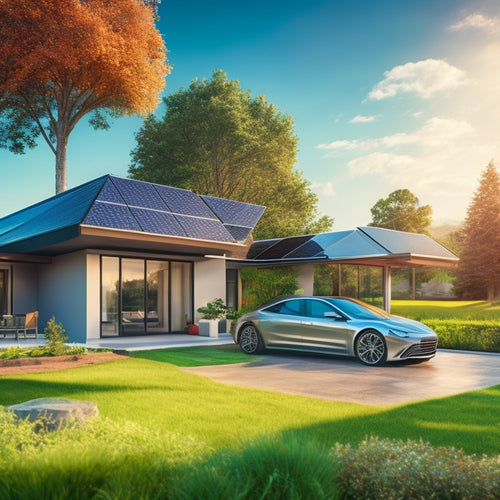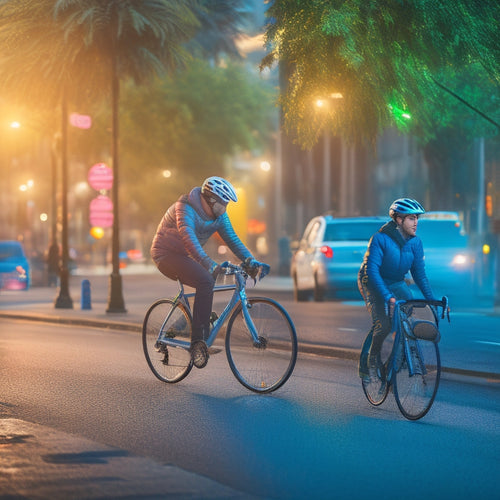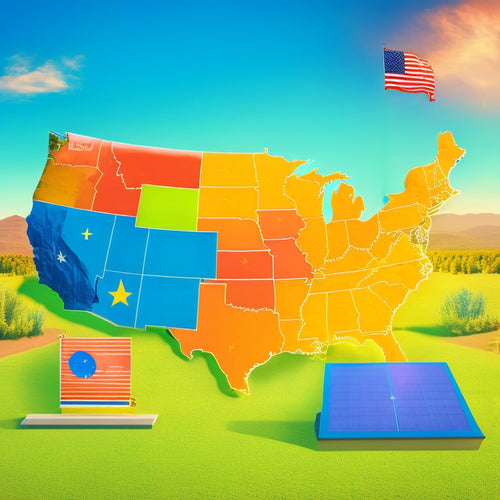
Must-Have Solar Panels for Emergency Cell Phone Charging
Share
When it comes to must-have solar panels for emergency cell phone charging, you need a reliable and efficient option that can keep your devices powered up in off-grid situations. Top brands like Anker, Goal Zero, and RENOGY offer high-energy conversion rates, durable designs, and user-friendly features. Look for solar panels with high efficiency ratings, compact designs, and durability in harsh environments. Consider the power output capacity, size, and weight of the panel, as well as its ability to charge multiple devices at once. As you investigate the world of solar-powered emergency charging, you'll find there's more to uncover about what makes a panel truly reliable.
Key Takeaways
- High-efficiency solar panels with ratings above 20% maximize power output in emergency situations.
- Compact and portable designs ensure easy storage and transport in backpacks or gear.
- Durable and weather-resistant materials, such as anodized aluminum and tempered glass, withstand harsh environments.
- Look for solar panels with high wattage ratings and USB compatibility for quick charging of multiple devices.
- Prioritize panels with robust construction, impact-resistant frames, and extreme temperature operation for reliable performance.
Top Solar Panel Brands
Several top-tier solar panel brands have established themselves as reliable options for cell phone charging. When choosing a solar panel, you'll want to evaluate brand comparisons and customer reviews to ascertain you're getting a high-quality product.
Anker, a well-known brand, offers a range of solar panels with high energy conversion rates and durable designs. Goal Zero, another popular brand, is praised for its user-friendly solar panels with built-in charging stations. RENOGY's solar panels are also highly rated, with customers raving about their compact designs and efficient energy output.
When comparing brands, look for factors like wattage, voltage, and amperage to guarantee the solar panel can charge your phone efficiently. Customer reviews can also provide significant perspectives into a brand's reliability, durability, and customer support.
Portable Power in a Pinch
When you're on-the-go, a portable solar panel can be a lifesaver, providing power in a pinch when you need it most.
Whether you're hiking through the wilderness or traveling to areas with limited power access, having a reliable source of backup power can be a significant advantage. In emergency situations, every minute counts, and a portable solar panel can give you the power you need to stay connected and call for help.
In terms of emergency preparedness, a portable solar panel is an essential item to have in your kit. It's lightweight, compact, and can be easily stowed away in a backpack or emergency bag.
With a portable solar panel, you can charge your cell phone, GPS device, or other critical gadgets, even when the grid is down. Look for a panel with a high-efficiency rating and a durable design that can withstand the elements.
With a portable solar panel, you'll have peace of mind knowing you have a reliable source of power when you need it most.
Charging on the Go Made Easy
Many hours of outdoor exploration can be supported by a portable solar panel, allowing you to charge your devices on the go.
Whether you're hiking, camping, or simply spending a day at the beach, having a reliable source of power is essential.
With a portable solar panel, you can rest assured that your devices will stay charged, no matter where your journeys take you.
To make mobile charging even more convenient, consider the following solar accessories:
- Solar-powered phone cases: These innovative cases have built-in solar panels, allowing you to charge your phone while on the move.
- Portable power banks: These compact batteries can be charged via solar power, providing an extra increase of energy when you need it most.
- Solar-powered charging hubs: These hubs allow you to charge multiple devices at once, making it easy to keep all your gadgets powered up while on the go.
Solar Panel Efficiency Matters
You'll want to take into account solar panels with high efficiency ratings, as they convert a larger percentage of sunlight into electricity.
A higher power output capacity also guarantees you can charge your devices quickly and efficiently.
When choosing a solar panel, look for models with efficiency ratings above 20% and power output capacities that meet your charging needs.
High Efficiency Ratings
Solar panels with high efficiency ratings are vital for maximizing power output, especially when charging your cell phone on-the-go.
You want to capture as much power as possible from the sun to keep your devices charged in emergency situations. High-efficiency solar panels guarantee you get the most out of your solar technology investment.
Recent solar technology advancements have led to significant improvements in efficiency ratings.
Here are three key benefits of high-efficiency solar panels:
-
Faster charging: High-efficiency solar panels can charge your cell phone up to 20% faster than lower-efficiency alternatives, making them ideal for emergency situations where every minute counts.
-
Compact design: With higher efficiency ratings, you can achieve the same power output with a smaller solar panel, making them more portable and convenient for on-the-go charging.
-
Increased reliability: High-efficiency solar panels are less prone to overheating, which means they're more reliable and durable, even in extreme weather conditions.
When comparing solar panels, look for high efficiency ratings to confirm you're getting the most power out of your investment.
This is especially important for emergency cell phone charging, where every watt counts.
Power Output Capacity
Twenty watts of power output may not seem like a lot, but it can make all the difference when you're stranded in the wilderness with a dead cell phone. You need a solar panel that can charge your device quickly and efficiently.
When it comes to power output capacity, you'll want to evaluate the type of solar panel you need. Monocrystalline solar panels, for instance, typically offer higher power output capacities than polycrystalline or thin-film panels. Look for a panel with a high wattage rating, especially if you have multiple devices to charge.
In addition to the type of solar panel, you'll also want to assess energy storage. A battery with a high capacity will allow you to store excess energy generated during the day for use at night or on cloudy days.
When choosing a solar panel, make sure it's compatible with your energy storage system. A higher power output capacity means you can charge your devices faster, giving you more time to focus on staying safe and finding your way back to civilization.
Size and Weight Considerations
Considering the constraints of backpacking or hiking, every ounce and inch of space in your gear matters. When it comes to solar panels for emergency cell phone charging, size and weight are essential considerations. You need a panel that's compact, lightweight, and efficient to guarantee it doesn't weigh you down or take up significant space in your pack.
To make the most of your gear, look for solar panels with the following features:
-
Compact design: A smaller panel is easier to stash away in your backpack or attach to your gear. Look for panels with a foldable or rollable design to save space.
-
Weight distribution: A well-distributed weight confirms the panel doesn't become unwieldy or difficult to manage. Opt for panels with a sturdy yet lightweight construction.
-
Efficient energy output: A panel that can generate power efficiently will reduce the weight and size needed to achieve your energy goals. Prioritize panels with high-efficiency solar cells.
Durability in Harsh Environments
When you're shopping for a solar panel to charge your cell phone, you'll want to make sure it can withstand the elements.
You'll need a panel built with weather-resistant materials that can handle rain, snow, and extreme temperatures.
Look for a model with an impact-resistant frame design that can absorb drops and bumps without compromising its performance.
Weather-Resistant Materials Used
Built to withstand the elements, solar panels for cell phone charging incorporate weather-resistant materials that guarantee durability in harsh environments.
When you're counting on your solar panel to keep your phone charged in an emergency, you need materials that can stand up to the rigors of nature.
To guarantee weather resistance, manufacturers use a range of material types that can withstand exposure to the elements.
These include:
- Anodized aluminum frames that resist corrosion and withstand extreme temperatures.
- Tempered glass that protects the solar cells from scratches and cracks, while also allowing maximum sunlight exposure.
- Waterproof coatings that seal out moisture and prevent electrical shorts.
Impact-Resistant Frame Design
Through rugged terrain and extreme conditions, your solar panel must endure impacts that could compromise its ability to charge your phone. That's why an impact-resistant frame design is vital for emergency cell phone charging. You need a frame that can withstand drops, bumps, and crushing forces without compromising the solar panel's performance.
Look for frame materials that offer exceptional strength-to-weight ratios, such as anodized aluminum or fiberglass-reinforced polymers. These materials provide the necessary rigidity to protect the solar cells while keeping the overall weight of the panel manageable.
Design innovations like reinforced corner brackets, shock-absorbing gaskets, and flexible hinge systems also play an essential role in distributing impact forces and reducing the risk of damage.
When evaluating a solar panel's impact resistance, consider the manufacturer's testing protocols and certifications, such as MIL-STD-810G or IP67 ratings. These standards confirm that the panel has been subjected to rigorous testing and can withstand the harsh environments you may encounter in emergency situations.
Extreme Temperature Operation
Your solar panel's ability to operate in extreme temperatures is just as essential as its impact resistance. When you're in an emergency situation, you can't afford to have your solar panel malfunction due to temperature extremes.
You need a panel that can withstand scorching heat and freezing cold, ensuring operational reliability when you need it most.
Here are three key temperature-related considerations for your solar panel:
-
High-temperature operation: Look for a panel that can operate at temperatures up to 149°F (65°C), ensuring it can handle direct sunlight in hot climates.
-
Low-temperature operation: A panel that can function at temperatures as low as -22°F (-30°C) will still provide power in freezing conditions.
-
Temperature coefficient: A low temperature coefficient means the panel's efficiency won't degrade markedly as temperatures rise, ensuring consistent power output.
Budget-Friendly Solar Options
With the rising popularity of solar-powered cell phone charging, it's no surprise that affordable options are flooding the market. You're no longer limited to expensive, bulky panels that drain your wallet and weigh you down.
Today, you can find budget-friendly solar options that won't compromise on performance. When shopping for an affordable model, look for compact designs that pack a punch. These panels are designed to be portable and efficient, making them perfect for emergency situations.
You'll find options with foldable or rollable designs that can easily fit in your backpack or purse. These compact solar panels may not generate as much power as their larger counterparts, but they're more than capable of charging your cell phone on the go.
For under $50, you can find a reliable solar panel that can charge your phone in a few hours. These affordable models are perfect for casual users or those who want a backup power source in case of emergencies.
With prices this low, you can't afford to be without a solar-powered cell phone charger.
Key Features to Look For
You'll want to focus on several key features when selecting a solar panel for cell phone charging to guarantee you get a reliable and efficient device.
With so many options available, it's essential to prioritize the right characteristics to make certain your solar panel meets your emergency power needs.
- Solar Panel Types: Look for monocrystalline or polycrystalline solar panels, which offer higher efficiency rates than thin-film panels.
Monocrystalline panels are more expensive but provide better performance in low-light conditions.
- Charging Speed: Consider the charging speed you need.
If you're in a hurry, opt for a solar panel with a higher voltage output (e.g., 18V) and a compatible USB port to charge your phone quickly.
- Portability and Durability: Assess the panel's weight, size, and build quality.
A portable and rugged design makes certain you can take the solar panel with you wherever you go, even in harsh outdoor conditions.
Frequently Asked Questions
Can I Charge My Laptop With a Solar Panel?
You're wondering if you can charge your laptop with a solar panel? Did you know 1 hour of sunlight can power a laptop for 2-3 hours? Check your laptop's wattage and verify the solar panel's compatibility and charging efficiency can meet its power needs.
Are Solar Panels Waterproof in Heavy Rain?
When you're out in the elements, you'll want to know if your solar panel can withstand heavy rain. Fortunately, most modern solar panels are designed with rain protection in mind, boasting IP65 or higher ratings, ensuring their durability and performance even in wet conditions.
Can I Use Solar Panels in Shaded Areas?
When you place solar panels in shaded areas, you'll reduce their efficiency. Optimize solar placement by avoiding shadows, as even partial shade can decrease power output.
How Long Does It Take to Charge a Dead Battery?
When you're relying on solar power, you'll want to know how long it takes to charge a dead battery. This depends on the battery capacity and charging efficiency; for example, a 5000mAh battery with 20% efficiency might take around 5 hours to fully charge.
Can I Connect Multiple Solar Panels Together?
You can connect multiple solar panels together to increase power output, but guarantee compatible solar panel types and consider solar charging efficiency to avoid voltage or current mismatches that reduce overall performance.
Related Posts
-

What Solar Panels Work Best With EVS Online?
When shopping for solar panels online to power your electric vehicle, look for high-efficiency models that can withst...
-

10 Essential Bike Lane Safety Features to Consider
You're designing a bike lane with safety in mind, and that's essential. The National Highway Traffic Safety Administr...
-

3 Best State and Local Solar Incentives USA
You can greatly reduce your energy dependence and save thousands of dollars by taking advantage of the top state and ...


